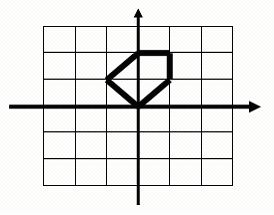Area
Time Limit: 1000MS Memory Limit: 10000K
Description
You are going to compute the area of a special kind of polygon. One vertex of the polygon is the origin of the orthogonal coordinate system. From this vertex, you may go step by step to the following vertexes of the polygon until back to the initial vertex. For each step you may go North, West, South or East with step length of 1 unit, or go Northwest, Northeast, Southwest or Southeast with step length of square root of 2.
For example, this is a legal polygon to be computed and its area is 2.5:

Input
The first line of input is an integer t (1 <= t <= 20), the number of the test polygons. Each of the following lines contains a string composed of digits 1-9 describing how the polygon is formed by walking from the origin. Here 8, 2, 6 and 4 represent North, South, East and West, while 9, 7, 3 and 1 denote Northeast, Northwest, Southeast and Southwest respectively. Number 5 only appears at the end of the sequence indicating the stop of walking. You may assume that the input polygon is valid which means that the endpoint is always the start point and the sides of the polygon are not cross to each other.Each line may contain up to 1000000 digits.
Output
For each polygon, print its area on a single line.
Sample Input
4
5
825
6725
6244865
Sample Output
0
0
0.5
2
Source
POJ Monthly–2004.05.15 Liu Rujia@POJ
一道基础计算几何题,就是在一串烦人的输入处理之后求组成的多边形面积,直接叉积算就好了。但要注意这题答案要开 不然会 (本蒟蒻亲身经历)
代码如下:
#include<iostream>
#include<cstdio>
#include<cstring>
#include<algorithm>
#define N 10000005
using namespace std;
struct pot{long long x,y;}p[3];
long long dx[10]={0,1,1,1,0,0,0,-1,-1,-1},dy[10]={0,-1,0,1,-1,0,1,-1,0,1},t,n;
long long ans;
inline long long cross(pot a,pot b){return a.x*b.y-a.y*b.x;}
char s[N];
int main(){
scanf("%d",&t);
while(t--){
scanf("%s",s+1);
n=strlen(s+1);
p[0].x=p[0].y=0;
p[1]=p[2]=p[0];
ans=0;
for(int i=1;i<n;++i){
p[1]=p[2];
p[2].x=p[1].x+dx[s[i]-'0'],p[2].y=p[1].y+dy[s[i]-'0'];
ans+=cross(p[1],p[2]);
}
if(ans<0)ans=-ans;
if(ans&1)printf("%lld.5\n",ans>>1);
else printf("%lld\n",ans>>1);
}
return 0;
}